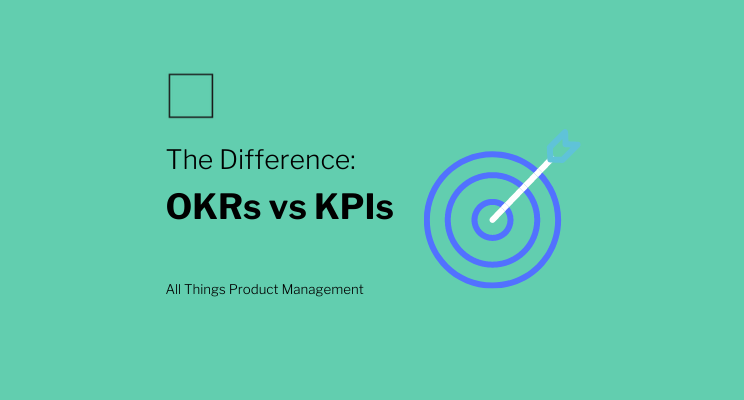Hey Product People! Carlos here. This week we’re touching on two concepts that often get confused: OKRs and KPIs. They’re similar but created for different purposes; tune in to find out what they are.
What they don’t tell you about being an adult when you’re in school is how many acronyms you’ll have to learn. That’s especially true in the tech/product world! BI, USP, FDD, GTM, JTBD, MVE, MVP, ROI, NPS, UX, UI, VOC…(If you’re already confused, don’t panic! There’s a glossary specifically for these things!) Today, we’re going to just focus on two. OKRs and KPIs.
OKRs and KPIs are two different systems for setting goals and measuring results. Sometimes they can seem pretty similar; that pesky K really trips people up!
We’ll go into what they are, the benefits of each, and how to implement them. This should give you a clearer understanding, and the confidence to move forward as a goal-setting, success measuring hero!
So let’s dive in.
What are OKRs?
OKR stands for Objectives and Key Results. Essentially, the OKR system sets targets and provides a means of measuring results.
They are usually set by c-level executives for the whole company to follow, keeping everyone on the same path.
Used by Google, Spotify, Airbnb, Twitter, and LinkedIn, the OKR system has been tried and tested by the best!
How do I set OKRs?
John Doerr, the famed venture capitalist originally brought OKRs to Google, and you can actually hear the man himself talking about them at TED:
The best way to structure an OKR is to use Doerr’s formula:
For example, this could be filled out as:
Your OKRs should always have some kind of metric, otherwise, they aren’t achievable. As Felipe Castro says, “Measurement is what makes a goal a goal. Without it…all you have is a desire.”
For example:
Experts recommend between 2-5 KRs for every O. Any more than 5 will be too complicated and much less memorable.
Your metrics should both complement and countermeasure each other. If you measure Customer Acquisition without also measuring Customer Retention, it sends the message that you only care about gaining new customers and not keeping them happy.
There’s also plenty of room for creativity. The best OKRs are snappy, memorable, and inspiring:
Google famously sets its OKRs too high for their teams to reach. The logic behind this is that they don’t expect their teams to reach their lofty targets, but they’ll push harder and achieve more. When talking about OKRs some experts quote Oscar Wilde: “Shoot for the moon. Even if you miss, you’ll land among the stars.”
It’s important to note here that OKRs uniquely are not tied to employee benefits/compensation. Because the goals are by default too ambitious, employees shouldn’t miss out on annual bonuses for not meeting them.
Are there different types of OKRs?
Yes, absolutely! The OKR system is all about being agile and making them work for you.
Teams can differentiate between aspirational and committed OKRs. Aspirational means knowing that you won’t hit all the KRs, but you’ll do really well trying! Committed OKRs are more fixed – these are the targets you’re expected to meet.
There’s also a difference between Strategic and Tactical OKRs. Sometimes teams need to work at different rhythms and the OKR system adapts to them by adopting a nested model. A Strategic OKR focuses on the bigger picture for the company, usually set annually by c-suite executives, whilst Tactical OKRs are more low-level for the teams working on individual products.
Why do companies love OKRs?
They’re agile: Setting goals every quarter instead of every year allows companies to adapt quickly, and gives them an opportunity to re-evaluate.
They provide clarity and cohesion: OKRs are visible to everyone at every level in the company, which provides transparency within the organization and makes sure everyone knows what direction the company is heading in.
They’re easy to understand: OKRs don’t have snappy language because they’re trying to be cool. Easy, colloquial language keeps things simple. By avoiding jargon anyone can understand what they mean.
They’re inspiring and ambitious: OKRs help to encourage and inspire teams to be their best. Sometimes referred to as ‘stretch goals’, Google expects their teams to reach 70% of their objectives.
They’re bottom-down AND top-up: Individuals get involved with goal-setting, as around 50-60% of a company’s OKRs are set by teams. This gets everyone more involved in the process and helps create a better understanding of the overall company strategy.
What are some common OKR mistakes?
Not differentiating between committed and aspirational OKRs. Teams need to know what’s expected of them – especially if you’ve tied rewards to committed OKRs!
Not being ambitious enough. The whole point of aspirational OKRs is to ‘shoot for the moon’. By not doing that you miss out on what people can achieve when they’re pushed and inspired.
Not setting enough, or setting useless KRs. Your KRs really do define the success of your Os.
To see some examples of what great OKRs look like, check out these Product Management OKRs from okrexamples.co.
What are KPIs?
KPI stands for Key Performance Indicator. The focus of a KPI is to measure success rather than set the goals themselves.
KPIs are a very common way of measuring how a company is growing as a whole, as well as keeping individual teams accountable.
How do I define KPIs?
Defining KPIs isn’t easy, as there are lots of factors to take into account. When you start the process, you should think of:
Your target outcome and why it’s important
Who is responsible for the outcome
How you’ll achieve it
How often you’ll re-evaluate the goal and your progress
The best KPIs are the ones that focus on outcomes and not business activities. To put it very simply, it doesn’t matter how many hours a person works if they don’t actually do anything productive. Measure how they do, not what they do.
Your KPIs should be set the same way. Focus on what you want to achieve at the end rather than what you want to do along the way.
Some common KPIs for Product Managers include:
Session duration
Customer Acquisition Cost
Daily Active User/Monthly Active User
Bounce Rate
Customer Satisfaction Score
Monthly Recurring Revenue
What are some common KPI mistakes?
Focusing on activities instead of results. If you focus on the number of revisions your developers make to a feature rather than how your users respond to it, you’re doing it wrong. The goal is to make users happy, not to show off how prolific your tech team is.
Choosing vanity metrics over sanity metrics. App downloads are a great metric, but if you don’t also look at bounce rate and retention, then they’re pure vanity.
Not choosing enough KPIs. One type of data can’t possibly hold all the answers. If you’re only getting half the picture, your decisions are only half-informed.
Choosing too many! On the flip side, if you are measuring too many things you can lose focus. Try to find a balance and make sure your KPIs are aligned with the goals you set for that project.
OKRs vs KPIs: What’s the Difference?
They’re both management tools that are designed to set goals and make sure growth is measurable, but they go about it in very different ways.
KPIs focus mostly on the outcome, whereas OKRs are also concerned with the process. OKRs speak to the larger vision, the big picture of what the company is trying to achieve, whereas KPIs aim to scale or improve a certain project.
KPIs are also more specific, and might be something like “increase market share by 10%” or “improve user retention by 15%.” An OKR is more general, only going into specifics with the KRs, for example:
O: Give our users a great customer service experience
KR: Reduce time between CS responses by X%
KR: Improve ratio of 5-star reviews in-app store to X:Y
The secret to OKRs and KPIs…you need both!
You need to be able to set realistic targets and hold your teams accountable, and you also need to be able to inspire and push for more ambitious results.
If you’re looking to improve the overall direction of your startup, OKRs are probably the better choice. If you need to improve the performance of a feature, plan, or product, look at your KPIs.
And that’s all, folks! Now you can move forward with 2 more acronyms under your belt—it’s that hard after all.
Got anything interesting to add? Share your thoughts in the comment section below.
Don’t forget to check out some of the previous issues!
What is Your Product’s North Star?














